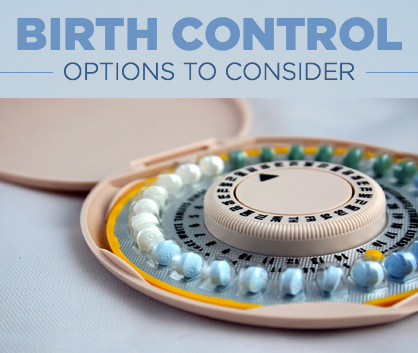10 Best Birth Control Methods
No matter your age, it’s easy to be confused with all of the different types of birth control options available. Your choice varies depending on your age, and whether you want to preserve your fertility for future childbearing.
Here are the best choices for anyone still interested in possibly having children, which means that permanent sterilization methods such as tubal ligation and vasectomies are better suited for those past their childbearing years, according to Sally Rafie, a Pharmacist specialist with the UC San Diego Health System and assistant clinical professor of health sciences for the UCSD Skaggs School of Pharmacy & Pharmaceutical Sciences. “Permanent methods such as vasectomies and tubal ligation are most popular among older women. The pro is that it is most effective and requires no maintenance, but the con is that it cannot be easily reversed, but this can be a pro for some,” Rafie said.


Consider goals, age, health
Contraceptive choices for women of all ages depend on their goals, their health and their clear understanding of the risks and benefits conferred by each option, said Antonio Pizarro, MD, a physician who is board certified in ob-gyn and in female pelvic medicine and reconstructive
surgery.
“Hormonal contraception include pills, patches, implants and vaginal ring. IUDs can work with or without hormones depending on patient choice and symptoms. Permanent contraception for women who wish no future childbearing comes in several forms and tubal implants have been the source of controversy. Condoms are highly effective when used properly and, unlike other forms, can also protect against some, but not all, sexually transmitted infections (STI),” Dr. Pizarro said.
“Emergency contraception must always be discussed, and its controversies are misplaced in my opinion. All forms of contraception carry risks and those risks are generally much lower than those posed by pregnancy, which can lead to health risks,” he said.
Top 10 methods of birth control
IUD
There are various types of IUDs, but the most popular is the Mirena IUD. It is a small, T-shaped device made of flexible plastic that regularly releases a small amount of progestin. Inserted by a doctor, the IUD works by preventing sperm from joining with an egg. The progestin thickens a women's cervical mucus and keeps sperm from reaching an egg. Costs about $500-$1,000.
- Effectiveness: More than 99% effective.
- Pros: It lasts five years, and is effective and completely undetectable during sex with no hassle before or after. Progestin may reduce cramps and make your period lighter over time. Some women experience a complete elimination of their period.
- Cons: After insertion, you may have a few days of mild cramping or a backache and, for the first three to six months, or even permanently, spotting between periods and/or irregular periods.
Implant
This is a small piece of flexible plastic implanted under the skin of the upper arm. The implant releases progestin into the body, which keeps sperm from joining with an egg. Insertion takes a few minutes, and the implant lasts for up to three years. Costs about $400-$800.
- Effectiveness: More than 99% effective
- Pros: It's long-lasting and effective. It's low profile and causes no hassle before, during, or after sex.
- Cons: You have to go through minor surgery for the implant. Irregular bleeding during the first six to 12 months is common.
Hormone shot
This is a single shot in the arm to release progestin, which thickens cervical mucus and thins the endometrium. It may also prevent ovulation, keeping sperm from joining with an egg. Costs about $35-$75 per injection.
- Effectiveness: 94-99% effective
- Pros: Administered by a doctor once every three months. Progestin can reduce menstrual bleeding and cramping and doesn't have many of the negative side effects of estrogen.
- Cons: The effects are long-lasting. Possible progestin side effects include irregular periods, sore breasts, headache, nausea, and more. Most side effects go away within three months. Rarer side effects include weight gain and changes in sex drive, among others.
Pill
One of the best known methods of birth control is the pill. This is an oral contraceptive containing estrogen and progestin. Estrogen stops egg production while progestin keeps sperm from reaching an egg. Costs $14-$50 per month.
- Effectiveness: 91-99% effective
- Pros: No hassle before sex. It has many other benefits, such as reducing painful periods, treating acne, treating mood disorders, and others. Another pro is taking the pill to skip periods.
- Cons: Skipping a day increases risk of pregnancy that day. Side effects might include nausea, vomiting, and spotting. Most formulations contains estrogen which is a problem for some women with medical conditions (such as blood clots or breast cancer).
Contraceptive vaginal ring
This is a small plastic ring inserted into the vagina once a month and left there for three weeks. It's taken out for the fourth week of the month. The ring releases estrogen and progestin into the body. Estrogen stops egg production; the progestin thickens a women's cervical mucus and keeps sperm from reaching an egg. Costs about $15-$80 per month.
- Effectiveness: 91-99% effective
- Pros: All you have to remember is to put the ring in on first day of month and take it out three weeks later.
- Cons: Estrogen and progestin can cause spotting between periods and irregular periods.
Contraceptive patch
This is a thin patch that sticks to the skin and releases the hormones estrogen and progestin into the body. Estrogen stops egg production; the progestin thickens a women's cervical mucus and keeps sperm from reaching an egg. Costs about $15-$80 per month.
- Effectiveness: 91-99% effective
- Pros: You put a new patch on the skin only once a month. For potential positive side effects of estrogen and progestin, see the section on hormonal IUDs.
- Cons: For potential negative side effects of estrogen and progestin, see the section on hormonal IUDs.
Morning after pill
This is the only type of birth control taken after sex. It can be taken up to five days after. It uses the same hormones as a birth control pill, but in slightly greater amounts. It is available at drugstores without a prescription if you are over 17. Costs $10-$70.
- Effectiveness: 89% effective when started within 72 hours after unprotected intercourse
- Pros: In the case of an accident or emergency, the morning-after pill is your best option.
- Cons: About 50% of women who take the morning-after pill feel queasy, but it usually goes away in under 24 hours. Other, less common side effects are abdominal pain, fatigue, headache, dizziness, and breast tenderness. Taking the morning-after pill too often can cause irregular periods.
Diaphragm
This is a dome-shaped cup with a flexible ring made of latex that is inserted into the vagina to cover the cervix. It blocks the opening to the uterus and prevents sperm from joining with an egg. Costs about $15-$75 and lasts two years.
- Effectiveness: 88-94% effective
- Pros: It's immediately effective and has no effect on your hormones. It can also be inserted hours ahead of time, so you don't have to worry about dealing with it just before sex.
- Cons: It requires a prescription and can't be used during your period. In some rare cases, it can cause urinary tract infections or allergy-related vaginal irritation. It's also messy and can be uncomfortable if not fitted properly.
Male condom
This is a thin latex sheath worn on the penis during intercourse, in order to collect semen and prevent sperm from entering the vagina. Condoms come in lots of shapes and sizes. They cost about $1 each.
- Effectiveness: 82-98% effective
- Pros: Rafie said, “Condoms are very popular among all because they are the only birth control method that also provides protection against sexually transmitted diseases or infections. Another pro is that it doesn't require advance planning, so you can grab one as needed when things are getting hot and heavy. For men, the pro is that they have control and can help prevent pregnancy and disease transmission.”
- Cons: For women, it can be a con if they have to rely on their male partner to use it. Another con is that it is not as effective as some other methods for pregnancy prevention (18% of users will get pregnant after one year), Rafie said.
Female condom
This is a plastic pouch with flexible plastic rings at each end. Before sex, it's inserted into the vagina; the ring at the closed end holds the pouch in the vagina, and the ring at the open end stays outside the vaginal opening during sex. They cost about $4 each.
- Effectiveness: 79-95% effective
- Pros: It's easy to get, and it puts women in control of pregnancy prevention. Female condoms cause no hormonal changes and decrease risk for sexually transmitted infections.
- Cons: Some couples feel that using a female condom has a negative effect on the quality of their sex life because it can be noisy and reduce feeling during intercourse. It can cause irritation and is messy.
Tagged in: health, birth control, iud, birth control pill,



